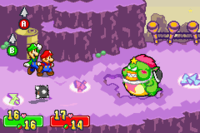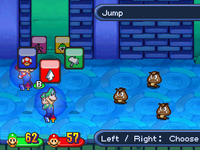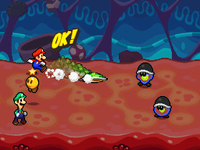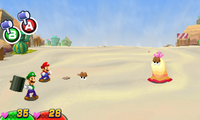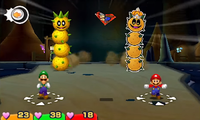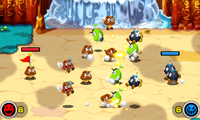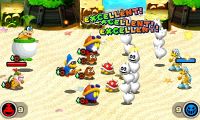The 'Shroom:Issue 151/AlphaDream Retrospective
Hey y'all, YoshiFlutterJump here. I'm sure many of us know at this point that AlphaDream, the devs behind the Mario & Luigi RPG series, has gone defunct due to bankruptcy. As the future of the beloved series remains uncertain, I write this section simply as a brief history of how far the series have come. All of these games hold a special place in my heart; from fantastic gameplay, to humorous writing, to just plain nostalgia, all of these games were thoroughly enjoyable to me from start to finish. So now I present to you...Alphadream Retrospective.
The series kicked off with Mario & Luigi RPG, known as Mario & Luigi: Superstar Saga outside Japan, in 2003 for Game Boy Advance. Building off the mechanics introduced in Super Mario RPG and Paper Mario, Superstar Saga took the action commands to a whole new level and had a special focus on brotherly teamwork. In addition to Mario, who had his jump and hammer attacks from before, Luigi joined in the fun as well. The story put the brothers in the Beanbean Kingdom on a quest to retreive Princess Peach's voice from the villainous Cackletta and her "most bestest pupil" Fawful. While simple, the real highlight storywise was the writing; you're not going five minutes without getting a good laugh at the dialogue. The battle system was a complete overhaul from its predecessors, as well; Action Commands are no longer just a helpful trick, but a necessity. With correctly timed hits, you could even counter enemy attacks. The game also introduced Bros. Attacks, which were special attacks that utilized the various moves Mario and Luigi have learned on their adventure. Outside battle, similar moves could be utilized to traverse the area, often requiring both brothers to change positions to perform various moves. One feature in Superstar Saga that has not returned in any of its sequels is the addition of elemental attacks. Mario could attack with fire, while Luigi could attack with electricity. Experimentation with these moves was encouraged, as some enemies were weak to different elements. The game was a hit, selling 2.15 million copies. It eventually got a Player's Choice release in 2006, and a Wii U Virtual Console release in 2014. The game would eventually receive an enhanced remake for the 3DS in 2017, which will be described in more detail below.
Two years later, Mario & Luigi RPG 2, known as Mario & Luigi: Partners in Time outside Japan, was released as the first installment for the Nintendo DS. Expanding on the ideas from the first game, the game utilized many hardware features on the new system, most notably the two new face buttons. The story begins where Princess Peach visits the Mushroom Kingdom of the past using E. Gadd's new time machine, but she was abducted by an alien race known as the Shroobs, so the two brothers must go back in time to rescue her, meeting younger versions of themselves and many other familiar faces. As a result, the baby Mario Bros. now serve as extra player characters. In addition to switching between Mario and Luigi, the baby brothers can be controlled as well, using the X and Y buttons. Sometimes, you'll need to switch between the two different brother pairs; other times, you'll have to control all four at once. In battle, with all four brothers together, while you can perform a standard Action Command with A or B, as in the first game, you can also utilize the babies to make your moves even stronger. For example, to jump, you can either press A to do a single jump, or you can press X to perform another jump afterward, and land the second jump with A. Bros. Attacks return as well, but they work significantly different from the first game; rather than using moves obtained outside battle as in-battle attacks, you can now buy consumable Bros. Items to trigger a minigame-esque special attack. While some of these can be used with only one pair of brothers, having both pairs together both enhances those attacks and allows for even stronger four-person attacks to be used as well. There are overworld Bros. Moves in this game as well, and each brother pair has its own set of exclusive moves. Later in the game, you are even able to combine these moves to use even more powerful variants. While some of this might seem overly complicated and maybe even a bit gimmicky, it actually works surprisingly smoothly, even if it comes at the cost of the first game's simplicity. While it wasn't quite as popular as the first game, Partners in Time still sold 1.76 million copies, and was released on the Wii U Virtual Console service in 2015.
In 2009, Mario & Luigi RPG 3 was released as the second installment in the series for the DS. Known as Mario & Luigi: Bowser's Inside Story outside Japan, the game introduces many new elements into the mix, with the most notable addition being that our favorite villain Bowser became a playable protagonist. The story had Bowser eating a Vacuum Mushroom that caused him to inhale many of the Mushroom Kingdom's residents. The Mario brothers must assist Bowser in taking down returning villain Fawful and his new minion Midbus, while looking for a way out of Bowser's body themselves. In contrast to how Mario and Luigi attack with jumps and hammers, Bowser attacks with fire breath and powerful punches. Bowser can also use special Brawl Attacks, which utilize the DS touchscreen to command a horde of Bowser's minions to attack those who stand in his way. At certain points in the game, Bowser can even grow giant, and fight equally-large bosses in special touch-controlled battles. However, Mario and Luigi are still part of the adventure, too. Much of the gameplay within Bowser's body takes place on a 2D plane, as opposed to a full 3D environment. Battling works very similarly to past installments, but the Bros. Attack system has been reworked once again; while based around certain attack items as in Partners in Time, they are no longer consumable and instead use up Bros. Points like in Superstar Saga. Outside battle, Bros. Moves can be used like in previous games, but as in Partners in Time, they are completely separate from the in-battle Bros. Attacks. What Bowser does in his adventure can impact what happens inside his body, too; for example, when Bowser drinks water, the area the Mario brothers are in fills up with water, allowing them to swim through. Bowser also has the ability to inhale enemies during battle, allowing Mario and Luigi to fight it instead. At a certain point in the game, Mario and Luigi gain the ability to leave Bowser's body and explore the Mushroom Kingdom, so switching between the two environments becomes a central mechanic in the game. The game introduced several more recurring features in the series as well, including the recurring character Starlow, the revamped badge system, the ability to rematch harder versions of bosses, and level ranks. The game became the best-selling game in the series, selling 4.56 million copies, and is widely regarded as the fan-favorite of the series. It also received an enhanced remake for the 3DS in 2019, much like Superstar Saga, and it will be described in more detail below.
In 2013, Mario & Luigi RPG 4: Dream Adventure was released as the first installment of the series on the Nintendo 3DS, and is my personal favorite of the bunch. Known as Mario & Luigi: Dream Team in America and as Mario & Luigi: Dream Team Bros. in Europe, the game expanded upon many ideas introduced in Bowser's Inside Story, complete with a beautiful new art style and an extra amount of Luigi appreciation. The story sees Mario and Luigi visiting a new island, where Princess Peach is kidnapped once again and an evil nightmare king of olden days has been let loose. With the help of new character Prince Dreambert and returning character Starlow, Mario must hop between the real world and the realm of Luigi's dreams in order to put a stop to this madness. Gameplay in the real world is not much different than in previous games, but it's the realm of Luigi's dreams where the sheer creativity of the game comes into effect. As Luigi can't come into his own dreams, an entity known as Dreamy Luigi, Luigi's own mental image of himself, joins Mario instead at these points. Dream world battles work wildly differently from real world battles; enemies come in much larger quantities, and in turn, Mario is assisted by an entire army of Luiginoids. Mario can also utilize a new form of attack known as Luiginary Attacks, which allow Mario to use his Luiginoid army in many different wacky ways. Outside battle, dream world gameplay is reminiscent of the 2D areas from Bowser's Inside Story, as the dream world is also set on a 2D plane. In certain areas, Dreamy Luigi can enter special objects known as Luiginary Works, which have varying helpful effects that can assist Mario on his adventure. These Luiginary Works are operated by utilizing the touch screen to have Starlow manipulate certain parts of the sleeping Luigi's face. Their effects can range from summoning a stack of Luiginoids, to manipulating movement speed, and even to removing gravity. As in Bowser's Inside Story, Dreamy Luigi will grow giant at certain points, initiating larger-than-life touch-controlled boss battles; however, they now makes use of the brothers' jump and hammer attacks. The dream areas themselves are based on the real-world areas they are accessed from, featuring reminiscent themes and level design while throwing in some dreamy twists. The game sold 2.58 million copies, earning a Nintendo Selects rerelease in 2016.
Keep in mind that the Paper Mario series was going strong as well during this time, with it having also received four installments. Paper Mario: Sticker Star, the newest game in the series at this time, had been the first game in the series to appear on a handheld, crossing over the imaginary boundary into the territory previously held exclusively by the Mario & Luigi series. Due to this, many saw a crossover on the horizon, and AlphaDream delivered with Mario & Luigi RPG: Paper Mario MIX for the 3DS in 2015. Known as Mario & Luigi: Paper Jam in America and as Mario & Luigi: Paper Jam Bros. in Europe, the game takes some cues from Partners in Time while also throwing in various elements from the Paper Mario series. While it's not exactly a 1:1 crossover, particularly indicated by its localized names as most of the gameplay takes after past Mario & Luigi games, it still takes a fair number of cues from Paper Mario and serves as a great entry point for fans who have previously only experienced that series. The story sees a clumsy Luigi accidentally knocking over a book containing the entire Paper Mario universe, resulting in many different paper characters jumping into the world of Mario & Luigi. Now there are two Bowsers...capturing two princesses...with two Marios to rescue them. Oh, Paper Luigi's here too, but he spends the entire adventure napping on the beach. Anyway, the biggest change to the gameplay is the addition of a third character, Paper Mario, who is controlled using the Y button. Battles now feature three characters instead of two, making battles that much more challenging as a result. Mario and Luigi fight identically to past games, still utilizing their jumps, hammers, and Bros. Attacks. Paper Mario throws in some twists, though. While he is significantly weaker than the other two on his own, by utilizing the Copy Block; while this takes up his turn, he can create up to six copies of himself, granting him five extra jumps, a hammer attack that can damage multiple enemies, and an extra layer of defense against enemy attacks. Paper Mario can also dodge attacks more easily than his three-dimensional counterpart. In place of Bros. Attacks, Paper Mario can utilize powerful Trio Attacks that involve all three brothers; however, if any one of the three bros is tripped or KO'd, these attacks cannot be used. Another addition here is the Battle Card system, replacing the badge system from previous games; the player can assemble a deck of 10 cards that can give various benefits in battle, such as lowering enemy stats, increasing EXP and coins, or outright damaging everyone on the field. In addition, this game allows you to block attacks as well, much like in the Paper Mario series, reducing the damage dealt, in addition to being able to dodge or counter attacks like in previous Mario & Luigi games. Overworld gameplay introduces new Trio Moves, replacing Bros. Moves from previous games, that utilize all three brothers in wacky ways. For example, Trio Grab allows them to grab things from afar, while Trio Glider has Paper Mario turn into a paper airplane and fly long distances. Another notable addition is the dash; while this existed with very limited control in Superstar Saga, Paper Jam allows full directional control and makes it much more useful when it comes to fast travel. There are also new minigame-like quests that see the trio rescuing various Paper Toads; these can be a pacebreaker at times, but they're also fun for the most part. The last notable additions here are the new Papercraft Battles. Replacing the Giant Battles from Bowser's Inside Story and Dream Team, these see the trio riding a larger-than-life papercraft, and bashing it into the equally-large enemy papercraft ridden by Bowser's minions. These battles take place in a full 3D environment, and utilize button control instead of touch control. Watching your Toad Meter is important; your papercraft is carried by Toads, and the Toads start to lose energy after every attack. To rejuvenate the Toads, you'll have to play a short rhythm minigame while being mindful of the enemy's location (you can be attacked during these minigames). The game sold only 1.01 million copies, so it wasn't quite a hit, but it's still another strong entry in a series of winners.
That was the last original Mario & Luigi game, but AlphaDream wasn't done yet. In 2017, they remade the first game in the series for the 3DS as Mario & Luigi RPG 1 DX. Known as Mario & Luigi: Superstar Saga + Bowser's Minions outside Japan, the game gives the original game a fresh new coat of paint, and throws in an additional side-story known as Minion Quest: The Search for Bowser. Superstar Saga, graphics aside, remained mostly untouched, although various features from its sequels were added to provide a smoother experience, such as the touch-controlled map and Paper Jam's Emergency Block. It's still as much fun as it was in 2003, however, so that's not inherently a bad thing. But the main new addition is Minion Quest, which follows the adventure of a Goomba destined for greatness during the events of Superstar Saga, as he searches for the Koopa king. The gameplay is something entirely new for the series, being more of a strategy RPG where the outcome of a battle is more dependent on what you do before battle rather than what you do within. The objective of each battle is to take out the enemy captain, while defending your own captain. Before battle, you can assemble a team of minions to assist you in battle. The game utilizes a rock-paper-scissors system, with each enemy type having its advantages and disadvantages. For example, melee troopers are strong against ranged troopers, but are weak to flying troopers. However, battling itself is largely hands-off. Action Commands return, but are significantly less prominent; at certain times a minion will unleash a special player-controlled attack, but that's about it. However, there is one other way the player can turn the tide of battles. Using a limited quantity of Captain Points, the player can activate a special Captain Command. These can have special, beneficial effects, such as canceling enemy special attacks, triggering a 1-on-1 sudden-death captain battle, or raising the stats of your allies. While it could be better, Minion Quest is still a fun little distraction from the main game. The game sold about 510,000 copies according to VGChartz; say what you will about that site's credibility, but it's no secret that Superstar Saga DX continued the series' trend of declining sales. Despite this, it's a solid remake of an already-fantastic game, and definitely the version you should go for if you have yet to experience the original.
Barely over a year after the previous remake, AlphaDream made another remake for the 3DS. Mario & Luigi RPG 3 DX, known outside Japan as Mario & Luigi: Bowser's Inside Story + Bowser Jr.'s Journey, is widely considered one of the most unnecessary remakes in the entire Mario franchise. After all, it was a remake of a game that has aged fairly well, came directly after another remake, released on a system that could already play the game in its original form and was dying rapidly, and failed to really add anything notable to the original. It's clear now that this was AlphaDream's final effort to bring themselves back from the brink. But to its merit, it's a solid new version of the best-received game in the series, with a fresh coat of paint and a brand-new side story. Much like Superstar Saga DX, little has changed from the original game. It throws in the Emergency Block from Paper Jam, adds giant battle rematches like Dream Team had, and removes the dreaded Retry Clock, but that about sums up all the changes made here. It gave fans an excuse to experience the classic again, and also served as a way to allow newer fans to experience it for the first time, but provided little reason by itself to warrant a re-purchase. Bowser's Inside Story is as epic as ever, though, and there are no real compromises made here, so The real selling point here is Bowser Jr.'s Journey, a sequel to Minion Quest that follows the adventures of Bowser Jr. during the events of the main game. It's not too different from its predecessor, featuring the same basic gameplay, but there are some differences. Unlike Minion Quest, where you could choose from among four different captains, Bowser Jr. is your only option here; however, as the game progresses, he'll eventually be able to change between the three basic trooper types, essentially functioning as three different captains. Teams now consist of nine troopers instead of eight, with an additional slot for a First Officer. The First Officer position may be held by Kamek or one of the seven Koopalings, and grants two additional Captain Commands that vary depending on the character. Enemy formations are also more customizable than before, and special team attacks can be used if you bring along multiples of the same enemy. It's fun, but much like Minion Quest, it's largely hands-off and primarily serves as a diversion from the main game. Unfortunately, the game sold only about 10,000 copies, which is shockingly poor for a Mario-franchise game, and was the final nail in the coffin for AlphaDream. But if you have yet to experience this classic, the remake is the way to go.
What does the future hold for Mario & Luigi? Your guess is as good as mine. With AlphaDream gone, Nintendo now holds full rights to the series, and can offhand the IP to whomever they wish. But with the shockingly poor sales of its newest entries, particularly Bowser's Inside Story DX, it's more of a matter of "will they bother". And even if they do give the IP to another studio, it's doubtful that they'll have the same magic touch that AlphaDream did. It's unclear for now what the future holds, but we can only hope that the series makes a comeback of any kind. This series means a lot to me, and I'd hate to see it go out like this. Thank you, AlphaDream. For everything.
That's all I have to say for now. See you around!
| The 'Shroom: Issue 151 | |
|---|---|
| Staff sections | Staff Notes • The 'Shroom Spotlight |
| Features | Fake News • Fun Stuff • Palette Swap • Pipe Plaza • Critic Corner • Strategy Wing |
| Specials | AlphaDream Retrospective |
